

A Natural Promise
Embracing Hope
5 March 2019
If hope is the thing with feathers, as Miss Dickinson the Empress of Calvary so forlornly opined a century and a half ago, then a seed is the thing with hope, a soon-to-be rooted counterpoint to wrenching despair, and a natural promise of life rising into the springtime air.
Today, as winter wanes, the Arkansas Native Seed Program is the thing seeded with hope — hope that denuded natural habitat can be restored, hope that life-giving riparian and prairie land can be strengthened and preserved, hope that grounded optimism and organized initiative can overcome the sense of societal resignation over dire and seemingly insurmountable threats to land, water, plants, and creatures — no matter what we might do.
Really? That bad? We don't think so.
For some of us, all is not lost. Our report today intends to illuminate one set of actions designed to enhance the good life where we live and play.
Naturally, it begins with a seed.
A Symbiotic Matrix of Action
About sixty folks from Arkansas, Oklahoma, and Missouri — farmers, naturalists, botanists, gardeners, activists, community leaders — accepted an invitation from the Beaver Watershed Alliance to attend its wintertime Quarterly Speaker Series at the West Fork Library on Thursday, February 21. The community of about twenty-five hundred souls draws its name from the West Fork of the White River, which flows along the eastern side of town, making it an ideal gathering place for the luncheon meeting.
Water from the West Fork tributary follows a northerly path into Beaver Lake, an aquatic jewel of great value to Northwest Arkansas. Like any urban stream beset by development, the West Fork faces challenges to bank stability, so the planting of native species along eroding streambank provides a natural solution: hardy plants with roots that run strong and deep. By meeting at West Fork, The Beaver Watershed Alliance sought to make it convenient for local farmers and landowners to pause from their labors and have a look and listen.
Jennifer Ogle, coordinator of the Arkansas Native Seed Program, and Jonathan Young, field project manager for Audubon Arkansas, took center stage as featured speakers. Although they represent different organizations, their efforts overlap and intertwine in the symbiotic matrix of ecological and environmental action typical of the field. Human and fiscal resources are finite — precious you might say — and resource managers cannot afford redundancy, waste, or duplication. Funding is tight. Volunteers are oft scarce. Leaders and doers are learning to work together.
'Keep It Local'
No wonder, then, that Ms. Ogle draws on the resources of a diverse array of public and private agencies, alliances, and departments to energize the seed program. All the while she follows one proven, minimalist credo: “Keep it local,” she told the West Fork audience. “Our common goal is to provide locally adaptive native seed for habitat restoration programs.”
The Arkansas Natural Heritage Commission, whose visionary leaders work on multiple fronts to preserve and promote the state's natural heritage, are taking the lead on the native seed program and have worked closely with the Arkansas Game and Fish Commission to fund Jennifer's position.
“The program's partners want to preserve the genetic diversity of our native plants,” she said. “By doing so, we can provide habitat for all the native animals that inhabit prairies and savannas — grasslands that are home for many animals, whether they be little insects or large mammals.”

Not for the Mower
Native grass grows tall in rural Washington County, Arkansas. Big bluestem, Indian grass, switchgrass, and little bluestem are among the native seeds under production by seed program farmer-volunteers.
Image by Beau Bosko for Crow's Cottage | 24 March 2017
Backbone and Protector
Why native seed when other, less esoteric strains from ready sources are available in the marketplace?
“Locally adaptive species, native plants, are the backbone of protecting ecosystems,” Jennifer told the audience. “They help protect declining animal species and their natural habitats. They filter nutrients. They slow stormwater runoff. And they require less fertilizer and supplemental water than non-natives.”
Profound Potential to Protect and Enhance
Clell Ford, Executive Director of the Beaver Watershed Alliance, enthusiastically endorses the seed program and Ms. Ogle's leadership. Clell's genuine enthusiasm and personal warmth fit nicely into the collegial atmosphere at the library's meeting hall.
“The Alliance has a wide variety of interests in the Arkansas Native Seed Program, including landowner engagement, creating a sustainable environment, and habitat restoration,” Mr. Ford said in an interview after the event. “The seed program has profound potential to protect and enhance habitat throughout Northwest Arkansas.”
Mr. Ford drilled down to the specific advantages of native plants to habitat restoration and preservation.
“Natives are critical for pollinators,” he said. “They reduce monoculture-dominated landscapes and are more resilient to the extremes of weather specific to Northwest Arkansas. Additionally, native plants, whether forbs and wildflowers or warm season grasses, are more sustainable in the long run for protecting stream banks and other physical aspects of the watershed.”
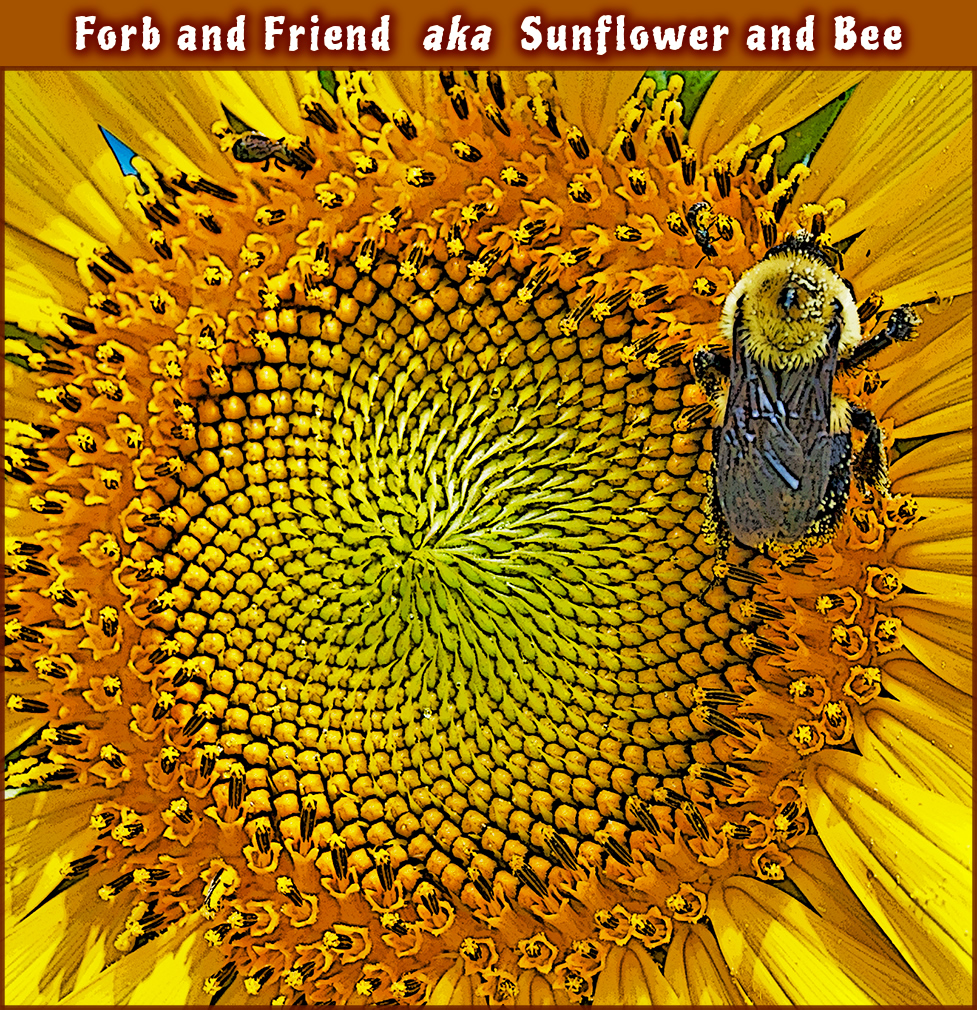
Image by Beau Bosko for Crow's Cottage | 5 August 2009 and 28 February 2019
A Staple of the Ecosystem
While tweaking and refining this report in the peaceful study at Crow's Cottage, one of our informal editors paused at the word “forbs” and said, “What? What on Earth is a forb?”
I'll admit to wondering the same — we're seldom shy about saying I don't know here at the Cottage — so I turned to the Alliance for an answer. Their erudite and smartly designed Riparian Planting Guide of the Ozarks complied, stating: “Forbs include all herbaceous flowering plants other than grasses, sedges, and rushes, and they are found in almost every ecosystem on Earth. As most wildflowers fall into the forb category, these plants are often easy to identify when in bloom. Common types of forbs include milkweeds, sunflowers, mints, smartweed, phloxes, and many others.”
Graminoids, shrubs, and trees complete the seed matrix. About 15 species are currently on the Arkansas Native Seed Program's planning table, Ms. Ogle reported. There's much to develop, much to refine.
“Not all of the species in our plans are in production at this time, as some of the seed was collected in the Ozarks, and we are still looking for a farmer to grow the seed for us,” she said. “So, for the time being, the seed that has been collected in the Ozarks is being stored in a climate-controlled facility.
“In previous years, mature seeds were collected in October through December to focus on summer and fall flowering species,” Jennifer continued. “This year we will expand to collecting in early to late summer as well.” She provided the following list of species previously collected.

Andropogon gerardii
››› big bluestem ‹‹‹
Baptisia alba
››› white wild indigo ‹‹‹
Ceanothus americanus
››› New Jersey tea ‹‹‹
Coreopsis grandiflora
››› large flowering coreopsis ‹‹‹
Dalea candida
››› white prairie clover ‹‹‹
Echinacea pallida
››› pale purple coneflower ‹‹‹
Eryngium yuccifolium
››› rattlesnake master ‹‹‹
Helianthus mollis
››› ashy sunflower ‹‹‹
Liatris pychnostachya
››› prairie blazing star ‹‹‹
Monarda fistulosa
››› wild bergamont ‹‹‹
Panicum virgatum
››› switchgrass ‹‹‹
Physostegia virginica
››› obedient plant ‹‹‹
Plectocephalus americanus
››› American basketflower ‹‹‹
Pycnanthemum tenuifolium
››› slender mountain mint ‹‹‹
Rhexia virginica
››› meadow beauty ‹‹‹
Rudbeckia grandiflora var. grandiflora
››› large coneflower ‹‹‹
Rudbeckia maxima
››› giant coneflower ‹‹‹
Rudbeckia missouriensis
››› Missouri coneflower ‹‹‹
Schizachyrium scoparium
››› little bluestem ‹‹‹
Silphium laciniatum
››› compass plant ‹‹‹
Sorghastrum nutans
››› Indiangrass ‹‹‹
Verbesina helianthoides
››› yellow crownbeard ‹‹‹
Vernonia missurica
››› Missouri ironweed ‹‹‹
Plan, Identify, Refine …
And Help!
What's next? Springtime, for one — can't wait. Practically, Ms. Ogle is working toward several interconnected objectives.
In the grand scheme, she is writing a strategic plan to link everyone involved in the program into a cohesive whole — a multi-layered task made easier by the spirit of cooperation and shared ecological values inherent in the enterprise. Imagine the challenge of bringing together the Arkansas Natural Heritage Commission, the Arkansas Game and Fish Commission, the U.S. Fish and Wildlife Service, the Arkansas Department of Transportation, The Nature Conservancy, Ozark Ecological Restoration, the Illinois River Watershed Partnership, the Beaver Watershed Alliance, and Audubon Arkansas! (That's worth the exclamation point, wouldn't you say?)
She also will work with partners to identify appropriate seed zones and determine demand for seed in Arkansas. Included in this objective is the identification of provisional seed zones for the Ozark Plateau.
She also will refine the list (shown above) of target species for collection. Then, working closely with Audubon Arkansas' determined Field Project Manager, Jonathan Young, she will help organize the planting and collection of seed.
Show Up at Harvest Time.
Wanna help? As always in an altruistic venture, volunteers are needed. “All you have to do is show up and help us collect seeds,” Jennifer said.
One area organization certain to provide volunteer assistance when the seeds are ready for harvest is the Northwest Arkansas Master Naturalists, a diverse cadre of citizens who pledge to devote a minimum of 40 hours each year to ecological and environmental stewardship.
“Jennifer is one of my environmental heroes,” Dave Leisure, President of Northwest Arkansas Master Naturalists said during an informal chat after the meeting at West Fork. Several master naturalists sat in the audience during the presentation — looking, as always, for another opportunity to fulfill their mission of volunteer service to the cause.
“Jennifer’s program of collecting local, native seed adds the word ‘balance’ to our conversation about the beneficial management of natural resources and natural areas,” Dave continued. “I am thankful for organizations like the Beaver Watershed Alliance, Audubon Society, Arkansas Natural Heritage Commission, and others that are willing to come together in a spirit of cooperation to further our ecological preservation and restoration efforts.”
So, dear friend of the natural realm, if you've ventured this far down the page, then you're likely to be interested in traipsing out into the fields come summer or autumn to join others for a rewarding experience a harvest time. Who do you call, you ask? Here are three solid leads:
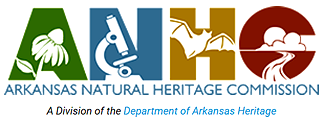
The Arkansas Natural Heritage Commission Volunteer Information webpage will lead you to Brian Mitchell, either via e-mail or telephone. While you're visiting, check out the Volunteer Photo Gallery. A click of the ANHC logo (above) will take you there.

Audubon Arkansas' volunteer program is open to individuals ages 16 or older who are interested in nature education and natural history. You'll find Jonathan Young's contact info on the “Volunteer With Us!” webpage — and be assured, Jonathan is another champion of seeds who'd love to have you in the fields for the harvest. Kindly click the logo and go!
One other way to volunteer is to write Jennifer Ogle a letter. Her address is
jennifer.ogle@arkansasnativeseed.com
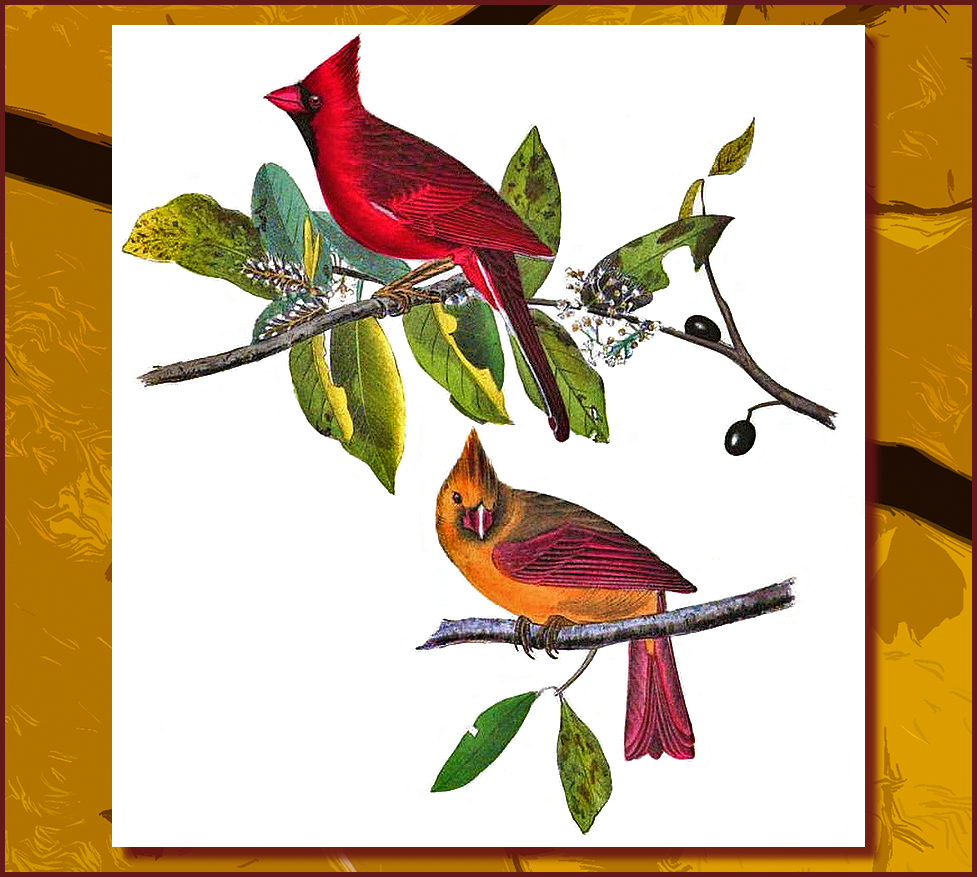
Northern Cardinal
Cardinal Grosbeak | Pitylus cardinalis aka Cardinalis cardinalis — Illustration adapted from a drawing by John James Audubon, F. R. SS. L. & E., in The Birds of America, Vol. III, 1841, J. B. Chevalier Publisher. Background painting of tulip poplar by Beau Bosko for Crow's Cottage.
What Do the Birds Ask?
Birdsong, “the tune without the words,” as Miss Dickinson wrote in her poem about hope, the tune that “never stops at all,” plays each day from sunrise to fading light here at Crow's Cottage.
Damaged ears silence most of my birdsong now, but my true love tells me the little birds sing with joyful clarity from the twigs and branches of their choir lofts in the cherry, the dogwood, the redbud, the golden raintree, the tulip poplar, the white pine, and the great old oak out front in the arboretum.
I watch with wonder and delight as the precious little creatures with feathers — cardinals, jays, woodpeckers, doves, sparrows, nuthatches, chickadees — alight and dine on seeds we spread across the limestone banquet tables outside my study window. I know they are singing, just as they have sung from the very beginning, when the sun first climbed over the new horizon to bathe the gardens and meadows at Eden with the light of life.
Miss Dickinson heard it, too, the bird with her song,
“in the chillest land,
and on the strangest sea;
Yet, never in extremity,
It asked a crumb of me.”
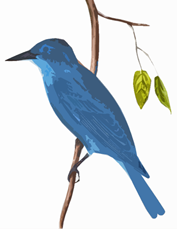
What, I wonder, do the birds of the Ozark highlands ask of us?
To Flourish and to Multiply
Jonathan Young, Audubon Arkansas' champion of seeds, hears in his heart the polite request of the thing with feathers, and he answers not with words but with action — proactive, collaborative hard work that's woven into the ongoing story of the Arkansas Native Seed Program.
Standing with Jennifer Ogle in the library of the little mountain town along the flowing West Fork creek, he told about his passion for the once-great prairie lands of the Mississippi River delta in eastern Arkansas and the diminishing grassy prairies of the Arkansas River Valley. “We have to start somewhere,” Jonathan said. “Grasses and birds are in sharp decline everywhere and diversity is on the brink of going away. We've got to turn the corner to increase and enhance the habitat on these remnant prairies, and we've got to educate folks about the need to do these kinds of actions.”
Give us a place to flourish and multiply, the birds might say to Jonathan — the birds he strives to help find homes on healthy native habitat and to feed with the bounty of native grasses, shrubs, and flowers — sown with seeds grown and harvested by Arkansas farmers and volunteers devoted to a program of hope.
“I'm fifty years old, and I'm not sure about how much impact I can have in the here and now, but the goals and objectives of this program need to happen,” he said. “I hope if I make it to seventy, I can look back and think that I've made a difference.”
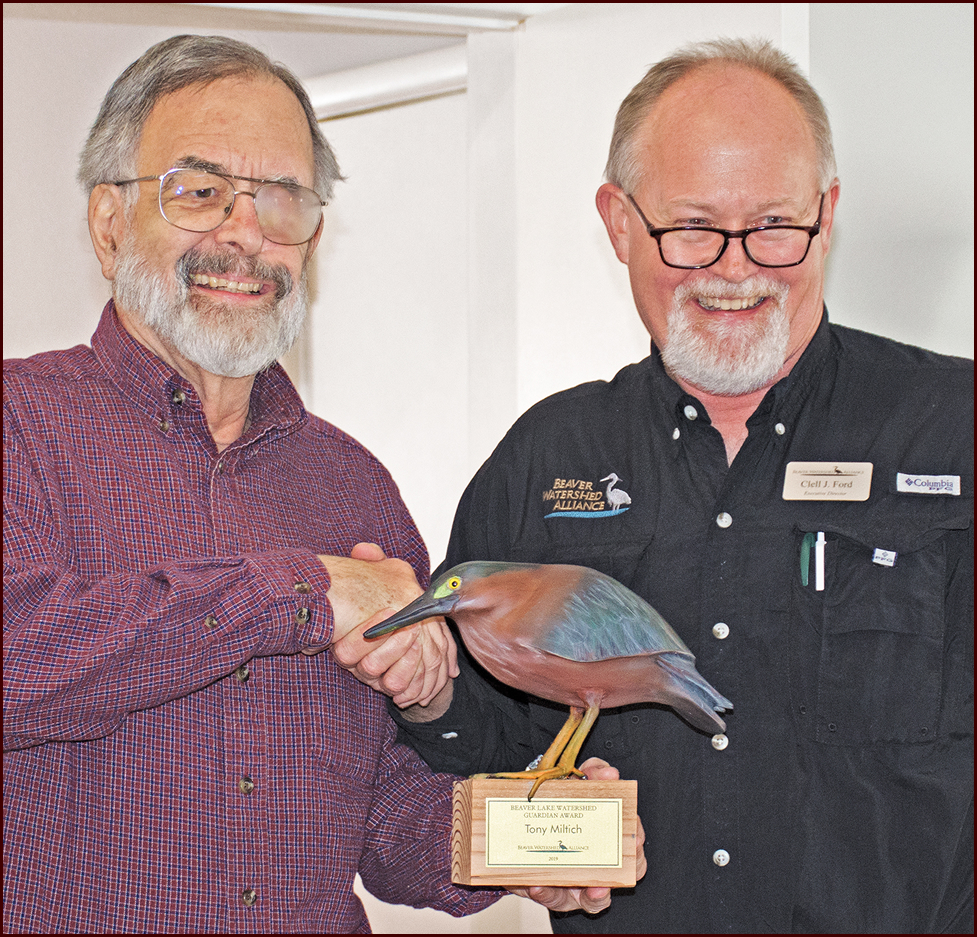
Making a Difference
Dr. Tony Miltich (left) receives the 2019 Watershed Guardian Award from Beaver Watershed Alliance Executive Director Clell Ford at West Fork, Arkansas, on 21 February. The award, depicting a green heron, recognizes Dr. Miltich's “dedication to the protection of the Beaver Lake Environment.”
Image by Beau Bosko for Crow's Cottage | 21 February 2019

The Way It Was
If you're visiting Crow's Cottage for the first or second time, a quick click on the crows below will give you an idea of how we once described our encounters with the natural realm. We sauntered away in 2015 for a necessary foray into professional wrestling, sidelining our nature writing and photography for several years. Now, at the dawn of 2019, we endeavor to return to an online exploration of flora, fauna, natural history, streams, rocks, stars, and planets. We hope you join us.
Crow's Cottage, a member of the CornDancer family of webs, is non-commercial, altruistic, and advert free. We follow an old-school philosophy devoted to the concept that the World Wide Web was — and perhaps still is — wired for sharing and communication, not for the naked promotion of commerce. But that's entirely another story for someone else to tell.
The linked pages hidden underneath the crows are best viewed on a pc or laptop screen. They were created back in the days when smart phones were designed for conversation. The older pages are also tolerably nice to visit on most tablets. We move with the times. Ahead, we hope … to who knows where along the path to a better future.
As always, we invite you to write us letter of encouragement or correction. You can even chastise us if you're respectful. Expect a courteous and timely reply. And let us know if you'd like to receive a notice about new features. Our address is ebenezer@crowscottage.com


